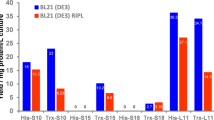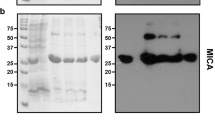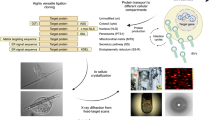Abstract
Production of recombinant proteins in bacteria is limited by the formation of cytoplasmic aggregates (inclusion bodies or “IBs”). This review summarizes what is known about why IBs form and ways of increasing the production of soluble protein in bacterial systems. The easiest way to lower IB formation is to reduce the growth temperature of the bacteria. IB formation is not directly correlatable with the production rate, nor with the size of the produced protein. The primary sequences of a few proteins that do not form IBs at higher production temperatures contain either a low content of proline residues or stretches of acidic amino acids. Metal ion binding may also lower the tendency to form IBs at growth temperatures above 30°C. Three aspects of protein synthesis in mammalian cells, compartmentation, interprotein interactions (sortases, foldases, unfoldases, and chaperonins), and post-translational modifications, have significant effects on the solubility of the proteins produced. Possibilities for mimicking these mechanisms in bacteria via secretion, cloning of mammalian foldases, and mutation of the post-translational modification systems of the host bacteria are discussed.
This is a preview of subscription content, access via your institution
Access options
Subscribe to this journal
Receive 12 print issues and online access
$209.00 per year
only $17.42 per issue
Buy this article
- Purchase on Springer Link
- Instant access to full article PDF
Prices may be subject to local taxes which are calculated during checkout
Similar content being viewed by others
References
Marston, F.A.O. 1986. The purification of eukaryotic polypeptides synthesized in Eschenchia coli. Biochem. J. 240:1–12.
Wittrup, K.D., Mann, M.B., Fenton, D.M., Tsai, L.B. and Bailey, J.E. 1988. Single-cell light scatter as a probe of refractile body formation in recombinant Escherichia coli. Nature Biotechnology 6:2423–426.
Hartley, D.L. and Kane, J.F. 1988. Properties of inclusion bodies from recombinant Escherichia coli. Biochem. Soc. Trans. 16:101–102.
Marston, F.A.O., Angal, S., Lowe, P.A., Chan, M. and Hill, C.R. 1988. Scale-up of the recovery and reactivation of recombinant proteins. Biochem. Soc. Trans. 16:112–115.
Hinnen, A., Meyhack, B., and Heim, J. 1989. Heterologous gene expression in yeast, p. 193–213. In: Yeast Genetic Engineering (P. J. Barr, A. J. Brake, P. Valenzuela (Eds.). Butterworths, In press.
Sedivy, J.M. 1988. New genetic methods for mammalian cells. Bio/ Technology 6:1192–1196.
Markussen, J., Diers, I., Hougaard, P., Langkjaer, L., Norris, K., Snel, L., Sorensen, A.R., Sorensen, E., and Voigt, H.O. 1988. Soluble, prolonged-acting insulin derivatives. III. Degree of protraction, crystallizability, and chemical stability of insulins substituted in positions A21, B13, B23, B27 and B30. Protein Engineering 2:157–166.
Schein, C.H. and Noteborn, M.H.M. 1988. Formation of soluble recombinant proteins in Escherichia coli is favored by lower growth temperature. Nature Biotechnology 6:291–294.
Haase-Pettingell, C.A. and King, J. 1988. Formation of aggregates from a thermolabile in vivo folding intermediate in P22 tailspike maturation. A model for inclusion body formation. J. Biol. Chem. 263:4977–4983.
Sturtevant, J.M., Yu, M.H., Haase-Pettingell, C.A. and King, J. 1989. Thermostability of temperature-sensitive folding mutants of the P22 tailspike protein. J. Biol. Chem. 264:10693–10698.
Bishai, W.R., Rappuoli, R. and Murphy, J.R. 1987. High-level expression of a proteolytically sensitive diphtheria toxin fragment in Escherichia coli, J. Bacteriol. 169:5140–5151.
Piatak, M., Lane, J.A., Laird, W., Bjorn, M.J., Wang, A., and Williams, M. 1988. Expression of soluble and fully functional ricin A chain in Escherichia coli is temperature-sensitive. J. Biol. Chem. 263:4837–4843.
Squires, C.H., Childs, J., Eisenberg, S.P., Polverini, P.J. and Sommer, A. 1988. Production and characterization of human basic fibroblast growth factor from Escherichia coli. J. Biol. Chem. 263:16297–16302.
Takagi, H., Morinaga, Y., Tsuchiya, M., Ikemura, H., and Inouye, M. 1988. Control of folding of proteins secreted by a high expression secretion vector, pIN-III-ompA: 16-fold increase in production of active subtilisin E in Escherichia coli. Nature Biotechnology 6:948–950.
Sidler, W., Niederer, E., Suter, F. and Zuber, H. 1986. The primary structure of Bacillus cereus neutral proteinase and comparison with thermolysin and Bacillus subtilis neutral proteinase. Biol. Chem. Hoppe-Seyler 367:643–657.
King, J. 1989. Deciphering the rules of protein folding. Chem. Eng. News 67(15):32–54.
Privalov, P.L. 1979. Stability of proteins, small globular proteins. Adv. Protein Chem. 33:167–241.
Pace, C.N., Shirley, B.A., and Thomson, J.A. 1989. Measuring the conformational stability of a protein, p. 311–330. In: Protein Structure, a practical approach. Creighton, T. E. (Ed.), IRL Press, Oxford.
Nover, L., and Scharf, K.D. 1984. Synthesis, modification and structural binding of heat-shock proteins in tomato cell culture. Eur. J. Biochem. 139:303–313.
Nguyen, V.T., Morange, M., and Bensaude, O. 1989. Protein denaturation during heat shock and related stress. Escherichia coli β-galactosidase and Photinus pyralis luciferase inactivation in mouse cells. J. Biol. Chem. 264:10487–10492.
White, J.H. and Richardson, C.C. 1988. Gene 19 of bacteriophage T7. Overexpression, purification, and characterization of its product. J. Biol. Chem. 263:2469–2476.
McCamen, M.T. 1989. Fragments of prochymosin produced in Escherichia coli form insoluble inclusion bodies. J. Bact. 171:1225–1227.
Mark, D.F., Lu, S.D., Creasey, A.A., Yamamoto, R. and Lin, L.S. 1984. Site-specific mutagenesis of the human fibroblast interferon gene. Proc. Natl. Acad. Sci. USA 81:5662–5666.
Evans, P.A., Dobson, C.M., Kautz, R.A., Hatfull, G. and Fox, R.O. 1987. Proline isomerism in staphylococcal nuclease characterized by NMR and site-directed mutagenesis. Nature 329:266–268.
Levitt, M. 1981. Effect of proline residues on protein folding. J. Mol. Biol. 145:251–263.
Wood, L.C., Muthukrishnan, K., White, T.B., Ramdas, L., and Nall, B.T. 1988. Construction and characterization of mutant iso-2-cytochromes c with replacement of conserved prolines. Biochem. 27:8554–8561.
Nagai, K., Thøgersen, H.C., and Luisi, B.F. 1988. Refolding and crystallographic studies of eukaryotic proteins produced in Escherichia coli. Biochem. Soc. Trans. 16:108–110.
Nagai, K. and Thøgersen, H.C. 1987. Synthesis and sequence specific proteolysis of hybrid proteins produced in Escherichia coli. Meth. Enzym. 153:461–481.
Dykes, C.W., Brookless, A.B., Coomber, B.A., Noble, S.A., Humber, D.C., and Hobden, A.N. 1988. Expression of atrial natriuretic factor as a cleavable fusion protein with chloramphenicol acetyltransferase in Escherichia coli. Eur. J. Biochem. 174:411–416.
Beck, Y., Bartfeld, D., Yavin, Z., Levanon, A., Gorecki, M., and Hartman, J.R. 1988. Efficient production of active human manganese superoxide dismutase in Escherichia coli. Nature Biotechnology 6:930–935.
Schülke, N., and Schmid, F.X. 1988. Effect of glycosylation on the mechanism of renaturation of invertase from yeast. J. Biol. Chem. 263:8832–8837.
Chung, K., Walter, P., Aponte, G., and Moore, H.H. 1989. Molecular sorting in the secretory pathway. Science 243:192–197.
Randall, L.L., Hardy, S.J.S., and Thom, J.R. 1987. Export of protein: a biochemical view. Ann. Rev. Microbiol. 41:507–541.
Dinnbier, U., Limpinsel, E., Schmid, R. and Bakker, E.P. 1988. Transient accumulation of potassium glutamate and its replacement by trehalose during adaptation of growing cells of Escherichia coli K-12 to elevated sodium chloride concentrations. Arch. Microbiol. 150:348–357.
Sieker, L.C., Turley, S., LeTrong, I., Stenkamp, R.E., Weller, P.F., and Ackerman, S.J. 1988. Crystallographic characterization of human eosinophil Charcot-Leyden crystals. J. Mol. Biol. 204:489–491.
Racker, E. 1983. Resolution and reconstitution of biological pathways from 1919 to 1984. Federation Proceedings 42:2899–2909.
Holt, C. and Sawyer, L. 1988. Primary and predicted secondary structures of the caseins in relation to their biological functions. Prot. Eng. 2:251–259.
Meyer, D.I. 1988. Preprotein conformation: the years major theme in translocation studies. TIBS 13:471–474.
Deshaies, R.J., Koch, B.D., and Schekman, R. 1988. The role of stress proteins in membrane biogenesis. TIBS 13:384–388.
Rothman, J.E. and Schmid, S.L. 1986. Enzymatic recycling of clathrin from coated vesicles. Cell 46:5–9.
Goloubinoff, P., Gatenby, A.A., and Lorimer, G.H. 1989. GroE heat-shock proteins promote assembly of foreign prokaryotic ribulose biphosphate carboxylase oligomers in Escherichia coli. Nature 337:44–47.
Kikuchi, T., Némethy, G., and Scheraga, H.A. 1988. Prediction of probable pathways of folding in globular proteins. J. Prot. Chem. 7:491–507.
Okumura, K., Wakayama, H., Miyake, Y., Murayama, K., Miyake, T., Seto, K., Taguchi, H., and Shimabayashi, Y. 1988. Thioredoxin-catalyzed refolding of recombinant protein: refolding of human prourokinase. Agric. Biol. Chem. 52:2969–2972.
Gleason, F.K. and Holmgren, A. 1988. Thioredoxin and related proteins in procaryotes. FEMS Microbiol. Rev. 54:271–298.
Freedman, R.B., Hawkins, H.C., Murant, S.J., and Reid, L. 1988. Protein disulphide isomerase: a homologue of thioredoxin implicated in the biosynthesis of secretory proteins. Biochem. Soc. Proc. 16:96–99.
Freedman, R.B. 1989. Post-translational modification and folding of secreted proteins. Biochem. Soc. Trans. 17:331–335.
Akagi, S., Yamamoto, A., Yoshimori, T., Masaki, R., Ogawa, R. and Tashiro, Y. 1988. Distribution of protein disulfide isomerase in rat hepatocytes. J. Histochem. Cytochem. 36:1533–1542.
Tasanen, K., Parkkonen, T., Chow, L.T., Kivirikko, K.I. and Pihlajaniemi, T. 1988. Characterization of the human gene for a polypeptide that acts both as the β subunit of prolyl 4-hydroxylase and as protein disulfide isomerase. J. Biol. Chem. 263:16218–16224.
Lin, L. and Brandts, J.F. 1984. Involvement of prolines-114 and -117 in the slow refolding phase of ribonuclease A as determined by isomer-specific proteolysis. Biochem. 23:5713–5723.
Takahashi, N., Hayano, T., and Suzuki, M. 1989. Peptidyl-prolyl cis-trans isomerase is the cyclosporin A-binding protein cyclophilin. Nature 337:473–475.
Fischer, G., Wittmann-Liebold, B., Lang, K., Kiefhaber, T., and Schmid, F.X. 1989. Cyclophilin and peptidyl-prolyl cis-trans isomerase are probably identical proteins. Nature 337:476–478.
Shieh, B-H., Stamnes, M.A., Seavello, S., Harris, G.L., and Zucker, C.S. 1989. The ninA gene required for visual transduction in Drosophila encodes a homologue of cyclosporin A-binding protein. Nature 338:67–70.
Bulleid, N.J. and Freedman, R.B. 1988. Defective co-translational formation of disulphide bonds in protein disulphide-isomerase-deficient microsomes. Nature 335:649–651.
Fisher, J.M. and Scheller, R.H. 1988. Prohormone processing and the secretory pathway. J. Biol. Chem. 263:16515–16518.
Langer, B.G., Weisel, J.W., Dinauer, P.A., Nagaswami, C., and Bell, W.R. 1988. Deglycosylation of fibrinogen accelerates polymerization and increases lateral aggregation of fibrin fibers. J. Biol. Chem. 263:15056–15063.
Dubé, S., Fisher, J.W. and Powell, J.S. 1988. Glycosylation at specific sites of erythropoietin is essential for biosynthesis, secretion, and biological function. J. Biol. Chem. 263:17516–17521.
Last, J.A. and Reiser, K.M. 1984. Collagen biosynthesis. Env. Health Perspectives 55:169–177.
Knight, P. 1989. The carbohydrate frontier. Nature Biotechnology 7:35–42.
Skerra, A. and Plückthun, A. 1988. Assembly of a functional immunoglobulin Fv fragment in Escherichia coli. Science 240:1038–1041.
Better, M., Chang, C.P., Robinson, R.R., and Horwitz, A.H. 1988. Escherichia coli secretion of an active chimeric antibody fragment. Science 240:1041–1043.
Tomich, P.K. 1988. Streptomyces cloning: Useful recombinant DNA systems and a summation of cloned genes. Antimicrob. Agents and Chemother. 32:1465–1471.
Adler, L. and Arvidson, S. 1988. Cloning and expression in Escherichia coli of genes encoding a multiprotein complex involved in secretion of proteins from Staphylococcus aureus. J. Bact. 170:5337–5343.
Nicaud, J.M., Mackman, N. and Holland, I.B. 1986. Current status of secretion of foreign proteins by microorganisms. J. Biotech. 3:255–270.
Chang, S. 1987. Engineering for protein secretion in Gram-positive bacteria. Meth. Enzym. 153:507–516.
Palva, I., Lehtovaara, P., Kääriäinen, L., Sibakov, M., Cantell, K., Schein, C.H., Kashiwagi, K., and Weissmann, C. 1983. Secretion of interferon by Bacillus subtitis. Gene 22:229–235.
Schein, C.H., Kashiwagi, K., Fujisawa, A., and Weissmann, C. 1986. Secretion of mature IFN-α2 and accumulation of uncleaved precursor by Bacillus subtitis transformed with a hybrid gene encoding the α-amylase signal sequence fused to the mature IFN-α2 gene. Nature Biotechnology 4:719–725.
Gieracsh, L.M. 1989. Signal Sequences. Biochem. 28:923–930.
Hsiung, H.M., Cantrell, A., Luirink, J., Oudega, B., Veros, A.J., and Becker, G.W. 1989. Use of bacteriocin release protein in E. coli for excretion of human growth hormone into the culture medium. Nature Biotechnology 7:267–271.
Li, P., Beckwith, J. and Inouye, H. 1988. Alteration of the amino terminus of the mature sequence of a periplasmic protein can severely affect protein export in Escherichia coli. Proc. Natl. Acad. Sci. 85:7685–89.
Chang, J.Y-H., Pai, R.C., Bennett, W.F., and Bochner, B.R. 1989. Periplasmic secretion of human growth hormone by Escherichia coli. Biochem. Soc. Trans. 17:335–337.
Davis, N.G. and Model, P. 1985. An artificial anchor domain: hydrophobicity suffices to stop transfer. Cell 41:607–614.
Hirst, T.R. and Welch, R.A. 1988. Mechanisms for secretion of extracellular proteins by Gram-negative bacteria. TIBS 13:265–269.
Weiss, J.B., Ray, P.H., and Bassford, P.J. Jr. 1988. Purified SecB protein of Escherichia coli retards folding and promotes membrane translocation of the maltose-binding protein in vitro. Proc. Natl. Acad. Sci. 85:9878–9882.
Akiyama, Y. and Ito, K. 1989. Export of Escherichia coli alkaline phosphatase attached to an integral membrane protein, SecY. J. Biol. Chem. 264:437–442.
Bieker, K.L. and Silhavy, T.J. 1989. PrlA is important for the translocation of exported proteins across the cytoplasmic membrane of Escherichia coli. Proc. Natl. Acad. Sci. 86:968–972.
Lazdunski, C.J. 1988. Pore-forming colicins: synthesis, extracellular release, mode of action, immunity. Biochimie 70:1291–1296.
Holland, I.B. 1989. Secretion of Escherichia coli haemolysin. Biochem. Soc. Transact. 17:323–325.
Blanchin-Roland, S. and Masson, J-M. 1989. Protein secretion controlled by a synthetic gene in Escherichia coli. Protein Eng. 2:473–480.
Georgiou, G., Shuler, M.L. and Wilson, D.B. 1988. Release of periplasmic enzymes and other physiological effects of β-lactamase overproduction in Escherichia coli. Biotech. Bioeng. 32:741–748.
Uhlén, M. and Abrahmsén, L. 1989. Secretion of recombinant proteins in the culture medium by Escherichia coli and Staphylococcus aureus. Biochem. Soc. Trans. 17:340–341.
Lin, L.-N., Hasumi, H., and Brandts, J.F. 1988. Catalysis of proline isomerization during protein folding reactions. Biochim. Biophys. Acta 956:256–266.
Tang, J., Wang, C. and Tsou, C. 1988. Formation of native insulin from the scrambled molecule by protein-disulphide isomerase. Biochem. J. 255:451–455.
Okumura, K., Miyake, Y., Wakayama, H., Miyake, T., Murayama, K., Seto, K., Taguchi, H., and Shimabayashi, Y. 1988. Effects of protein disulfide-isomerase on the refolding of human pro-urokinase cloned and expressed in Escherichia coti. Agric. Biol. Chem. 52:1735–1739.
Cozzone, A.J. 1988. Protein phosphorylation in prokaryotes. Ann. Rev. Microbiol. 42:97–125.
Chiang, T.M., Reizer, J., and Beachey, E.H. 1989. Serine and tyrosine protein kinase activities in Streptococcus pyogenes. J. Biol. Chem. 264:2957–2962.
Hoess, A., Arthur, A.K., Wanner, G. and Fanning, E. 1988. Recovery of soluble, biologically active recombinant proteins from total bacterial lysates using ion exchange resin. Nature Biotechnology 6:1214–1217.
Cheng, Y.E., Kwoh, D., Kwoh, T.J., Soltvedt, B.C. and Zipser, D. 1981. Stabilization of a degradable protein by its overexpression in Escherichia coli. Gene 14:121–130.
van Kimmenade, A., Bond, M.W., Schumacher, J.H., Laquoi, C., and Kastelein, R.A. 1988. Expression, renaturation and purification of recombinant human interleukin 4 from Escherichia coli. Eur. J. Biochem. 173:109–114.
Author information
Authors and Affiliations
Rights and permissions
About this article
Cite this article
Schein, C. Production of Soluble Recombinant Proteins in Bacteria. Nat Biotechnol 7, 1141–1149 (1989). https://doi.org/10.1038/nbt1189-1141
Issue Date:
DOI: https://doi.org/10.1038/nbt1189-1141
This article is cited by
-
Construction of a constitutively active type III secretion system for heterologous protein secretion
Applied Microbiology and Biotechnology (2023)
-
Optimized expression of Hfq protein increases Escherichia coli growth
Journal of Biological Engineering (2021)
-
Identification of host factors limiting the overexpression of recombinant Cu, Zn superoxide dismutase in Escherichia coli
Biotechnology Letters (2020)
-
Intein-Mediated Fusion Soluble Expression of Recombinant Human Interferon Beta (rhIFN-β)
Iranian Journal of Science and Technology, Transactions A: Science (2020)
-
Heterologous expression, purification, and refolding of SRY protein: role of l-arginine as analyzed by simulation and practical study
Molecular Biology Reports (2020)



